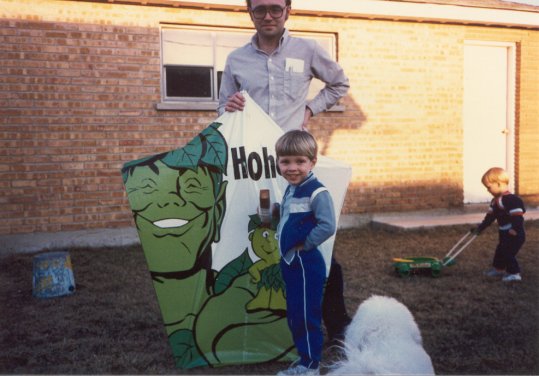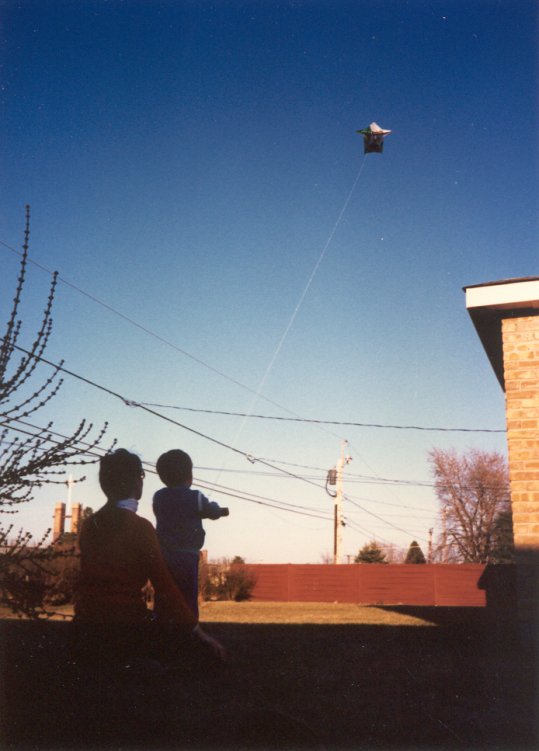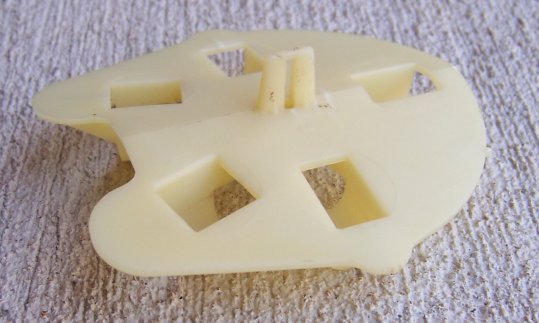
Promotional kites are an ancient business, basically as old as the business of manufacturing inexpensive kites as toys for kids. I've seen promotional diamond kites from Wilder Mfg. and Alox Mfg. that date back to the Depression, and I suspect that Hi-Flier was making them back then as well. By the 1950s, promo kites were a huge business for Hi-Flier, and I had many of them when I was growing up in the 1960s. (The one I remember best came from Cundiff's Sinclair over at Harlem and Higgins in Chicago.) Promo kites mostly vanished with the American manufacturers around 1990. What promo kites I've seen since then have come (like most inexpensive toys) from China.
I pick up or send away for promo kites any time I can, to see what sorts of things are being passed off as kites these days. It's no wonder that kite flying among kids has gone into eclipse: Plastic promo kites are almost always lousy kites, probably designed by people who have never flown a kite and may never have actually seen one except in photographs.
Almost.
Flying the Giant
Back in the spring of 1987, during the few weeks that I spent moving from Baltimore to Scotts Valley, California to work at Borland, I was handed a bagged plastic kite by my 4-year-old nephew Brian, who asked me to put it together and fly it with him. His mother had sent away a couple of proof-of-purchase seals (which I still call "boxtops") from frozen vegetables, and they had received the kite from the Green Giant company. The kite that we found in the bag was impressive enough to warrant a short article all by itself. As a promo kite, it stands completely apart: No kite I have ever gotten with a purchase or sent boxtops away for has ever worked anywhere near as well.

The kite is shown here, with Uncle Jeff, Brian at 4, and 2-year-old Matt toward the right edge. (My bichon Mr. Byte is the white item on the photo's lower edge.) At 48" high and 42" wide it dwarfed both boys. Assembling it had been easy: Five tubular plastic sticks plugged into a central hub, and little plugs at the ends of the sticks had blunt protrusions that fit into reinforced holes in the sail at the five points of the kite. The top stick (making the upper point in the five-sided kite) was 12" long. The two side sticks were each 21" long. The two bottom sticks were 36" long. The sticks were actually in two thicknesses: The top three were 5/16" in diameter, and the two lower sticks (which were the longest, at 36") were 3/8" in diameter. The long sticks probably needed the extra diameter for rigidity, but having the sticks in two sizes meant that the kite was almost impossible to assemble incorrectly. The sticks snapped into place easily and stayed put without glue.
There was no bridle. The string tied to a loop at the center of the plastic hub, which protruded through a hole in the center of the kite's plastic sail. (See the closeup photo below.) Now, I've flown bow kites with single-point bridles, and while it can be done, they generally fly much more reliably with the classic, two-point bridle. I remember being skeptical while reading the instructions, which indicated that the kite needed neither tail nor any bridle other than the string tied to the kite's center point.
But we followed the instructions to finish the kite, attached a roll of string that had been wound on a piece of scrap 1 X 1 lumber, and took it out into Grandma's back yard in Niles, Illinois. I had my doubts about its stability, and biggish trees were all around, so Carol took the photo before we launched it. That way, we would be sure to remember it if its lifetime proved to be measured in seconds, as sometimes happens with kites. Brian is holding the string in the photo. There was a light breeze from the south; I would guess 5-8 MPH. That's not a lot of wind for kites, but the Green Giant kite was extremely light for a kite that large, and I suspected it would rise without difficulty.
And it did. With Brian holding tight to the roll of string, I took the kite back about ten feet, lifted it up over my head, and just let go. It didn't just rise; it zoomed. I helped Brian let some string out, and in a minute or so the kite was floating almost still on the wind, fifty feet over the church parking lot that abutted Grandma's back yard. We took it out about 200 feet, which was all the string we had, but the boys were delighted. It danced back and forth a little as the wind shifted, and I was poleaxed by how little it leaned to either side. It might have reacted differently to a stronger wind, but in a light spring breeze it flew almost perfectly. I showed Brian how to wind it back in, and in a little while the Green Giant and Sprout were safely back on the grass.

The kite remained in Grandma's basement, and I think the boys flew it on their own a few years later. At some point the sail tore, and the wounded kite sat in a corner of the basement until the summer of 2006, when we cleaned out the house to be sold. I salvaged the sticks and the center connector, thinking I might re-cover it someday, but two of the sticks turned up missing before I got them home. I never rebuilt it, but I still have the center connector, which I feel is the key to the kite's success. There is no bow-string. The center connector (shown in the photo) has a 15° dihedral angle, providing the necessary "bow" that makes the kite stable. Precisely cut sticks and sail plastic made for very good balance, and it still rates as one of the most stable kites I've ever flown, and that with no tail whatsoever!

The Secret Origin of the Green Giant Kites
It was only recently that I determined where the Green Giant kites had come from. According to a small logo molded into the center connector, the kite was made by RB Toy Development Company of Mt. Prospect, Illinois, which (a little weirdly) is only a few miles west of Grandma's house where we flew the kite. I called the company, and spoke at some length with the current owner, Dennis Kupperman. RB had been founded by his father Sam Kupperman in 1958, and has been in the advertising premium business all that time. Sam is now retired and living in Florida, but Dennis was most gracious, and he told me the whole story of the Green Giant kites.
The Green Giant story is interesting in itself. In 1928, the Minnesota Valley Canning Company created a green giant figure as their trademark. It was not an appealing figure, hunched and grumpy looking, and for whatever reason not memorable. But starting in the 1930s, a young advertising genius named Leo Burnett gradually refined the giant into the cultural icon we know today. Early TV representations didn't work well, because giants were generally the heavies in storybook tales, and very small children found the giant frightening. The Burnett agency grafted a little Santa Claus into him, giving him an ever-present broad smile, calling him the Jolly Green Giant, and even made him laugh with Santa's "ho ho ho." It worked, and the Giant has endured even through multiple changes in ownership for the canning company itself.
In 1970, someone at Leo Burnett had the idea of putting the Jolly Green Giant on a kite as a sales premium. They created a large kite with the Giant as a design, and printed 20,000 of them, only to find (after the kites were printed!) that the kite would not fly. At that point the agency contacted RB Toy Development Company, with whom that had worked before on sales premiums targeted at children. Dennis Kupperman is an engineer, and while he was not trained specifically in aerodynamics, he read what he could on kites, looked at kites sold by Hi-Flier and other firms, and came up with his own design. Dennis and Sam were granted US design patent #225653 on the center connector and general kite configuration. Dennis related how he had demonstrated the kite to Leo Burnett in downtown Chicago on Michigan avenue, in the shadow of the Prudential Building where Burnett's corporate offices were located. The agency loved it, and soon delivered the artwork for the first run.
The Burnett graphics showed the Giant in full, standing feet together with outstretched arms. It was a good design, recognizable as a human figure when the kite was a long way out. The only problem was that once the kite was up a little ways and flying in bright light, the green color washed out and the Giant figure looked a lot like the crucified Jesus. A few church groups complained, and the Burnett Agency responded as the class act that they were, by recalling and destroying all kites that were waiting to be shipped, and eating the full cost of the error. They redesigned the graphics with the Giant in a pose that could not be confused with Jesus nor anyone else, and the kites went into production again.
This time there were no hangups: The kites flew like banshees, and the Green Giant design was a huge hit. Between 1971 and 1990, the Green Giant Company fielded numerous kite promotions under several different designs, with the Giant alone or with Sprout, his diminutive sidekick, introduced by the Burnett Agency in 1973. One premium package included a small Sprout figure hanging from a parachute, which could be set on the string and blown by the wind up to the kite, at which time a sharp tug on the string would (usually) launch the Sprout on a parachute ride back to Earth. Dennis related a story of taking a Green Giant kite out to a park in Skokie with a bag full of rolls of kite string, and sending the kite out on one roll of string after another, until the kite was 3,000 feet away and invisible except in binoculars. Even winding the kite in on a Hi-Flier Spinwinder was a lot of work, and at some point Dennis just broke the string, figuring that someone, somewhere would find the kite and adopt it.
RB had and still has an exclusive on kites bearing the Green Giant trademark, and no other company has ever legitimately manufactured a Green Giant kite. RB has made kites as premiums for many other companies and products (including Coke, Red Baron Pizza, and Kool Aid) but in honor of the Giant's being the first (and, after all, being a giant) all of RB's other kites have been three inches shorter and three inches narrower. All of the Green Giant kites are now collectibles, and Dennis has gotten very good prices for the few he has sold out of leftover inventory.
When I asked Dennis about the prospects for more RB kites, whether of the Green Giant design or any other, he told me what I pretty much expected: That cost-squeezed companies are rarely willing to commit the sort of money that it takes to do ambitious premium promotions anymore, and that kites generally are not seen as the big draw that they were twenty or thirty years ago. Creating the rubber printing plates alone costs $10,000 - $15,000 each, and the large drum presses used to print the kite designs on plastics are now being retired in favor of smaller presses that won't print anything as large as the Giant. Injection molding the center connector cannot be done in small batches, so runs of less than 25,000 are not economically feasible. Getting kites into retail stores might be possible, but Dennis doesn't want to be in that business (retail distribution can be ugly and expensive--as I know from my years in book publishing) and he isn't sure that the kite market is big enough these days to make low-cost plastic kites profitable. That said, he's still got everything he needs to assemble the 45" kites (assuming the plastic sails can be printed somewhere) so if you have the money and a way to distribute them, he'd like to hear from you.
Alas, he can only sell Green Giant kites to the Giant's parent company, and that sort of big-time premium campaign has passed into history. So if you've got a Green Giant kite, promote it to wall art, because if it goes into the trees you won't be getting another one any time soon. I see them every so often on eBay and they're worth watching for, though you probably won't get them for $10. I'm hanging onto the center connector that I have, and may rebuild it with wooden dowels and a cloth sail at some point. The general design of a barn-door kite with a bow is a good one, and an example (called a "flat-nose bow kite") can be found in Marion Downer's classic book Kites: How to Make and Fly Them. It might be possible to make a dihedral center connector for a similar kite out of a sheet of aluminum, but in general it's a bad idea to have metal parts in kites. Ben Franklin was many things, but most of all he was...lucky.
Ho Ho Ho!
That's the story of the Green Giant kites and the man who created them. Conventional wisdom assumes that "boxtop" premium offers provide only the cheapest and lousiest goods, but in this one case, conventional wisdom got spanked and sent home without supper. The RB Green Giant was an amazing kite, and if all promo kites assembled this easily and flew this well, there might still be a promo kite industry--and kids might still be flying kites like they did in the 1960s.